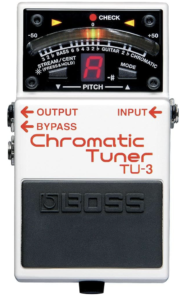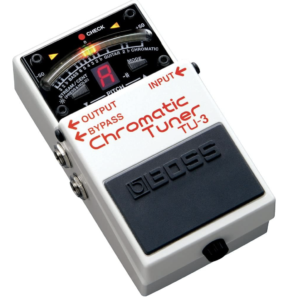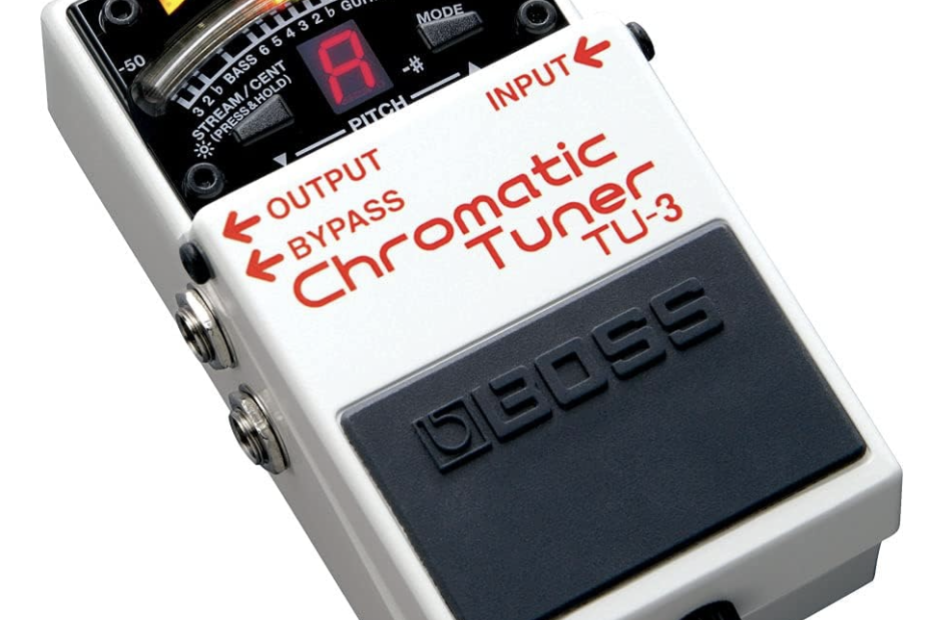The Boss TU-3 Chromatic Tuner is a highly popular and reliable tuner pedal designed for electric guitars and basses. It’s part of Boss’s well-respected line of compact guitar pedals and is known for its durability, accuracy, and ease of use. Here are the key features and details of the Boss TU-3:
Chromatic Tuning
 The TU-3 [link] offers chromatic tuning, which means it can tune to any pitch within its detection range. This makes it suitable for standard tuning as well as alternative and drop tunings.
The TU-3 [link] offers chromatic tuning, which means it can tune to any pitch within its detection range. This makes it suitable for standard tuning as well as alternative and drop tunings.
The pedal features a bright LED display that is easy to read on stage, even in various lighting conditions. The display indicates whether the note is flat, sharp, or in tune.
The TU-3 is known for its fast and accurate tuning response. It uses Boss’s proprietary Accu-Pitch technology, which provides a visual confirmation when the pitch is correct.
In addition to standard chromatic tuning, the TU-3 offers different tuning modes, including Guitar, Bass, and Flat. These modes cater to various instruments and tuning preferences.
The pedal includes a high-precision strobe tuning mode for fine-tuning your instrument with exceptional accuracy. The strobe mode is particularly useful for musicians who require precise tuning, such as those using alternate tunings or working in a studio.
The TU-3 features true bypass switching, ensuring that your guitar’s signal remains unaltered when the pedal is not engaged. This preserves your tone and signal integrity.
Also Read:
TC Electronic POLYTUNE 3 Tuner Review
7 Best Clip On Guitar Tuner Options
D’Addario Guitar Tuner Pedal
How to Tune a Guitar with a Tuner
Squier Affinity Series Deluxe Telecaster
More Features
Segment LED Meter: The LED meter on the display provides a visual representation of the tuning process. It consists of 21 LEDs that give you a detailed view of your instrument’s pitch.
Boss pedals are known for their rugged build quality, and the TU-3 is no exception. It’s built to withstand the rigors of the road and is housed in a sturdy metal chassis.
The pedal can be powered using a 9V battery or an external 9V DC power supply. It also includes a DC output for daisy-chaining other pedals from a single power source.
Buffered Output: The TU-3 features a buffered output, which can help maintain your guitar’s signal strength and prevent signal degradation in long cable runs or complex pedalboard setups.
Support for Guitar and Bass: The TU-3 is suitable for both electric guitars and bass guitars, making it a versatile tuning solution for a wide range of players.
Using Boss TU-3 Chromatic Tuner
 Using the Boss TU-3 Chromatic Tuner [link] is straightforward, and it offers both chromatic tuning and alternate tuning modes. Here’s how to use this popular tuner pedal:
Using the Boss TU-3 Chromatic Tuner [link] is straightforward, and it offers both chromatic tuning and alternate tuning modes. Here’s how to use this popular tuner pedal:
Power On the Tuner
Ensure that your TU-3 is properly powered. You can use a 9V battery or an external 9V DC power supply. Connect your guitar or bass to the input of the tuner pedal.
The TU-3 offers both chromatic tuning and alternate tuning modes. To access chromatic tuning mode, press the “MODE” button until you see “CHROMATIC” displayed on the screen. To access alternate tuning modes, press the “MODE” button until you see the desired mode (e.g., “GUITAR,” “BASS,” “DROP D,” etc.).
Play a String
If you’re using chromatic mode, play a single string on your instrument. The TU-3 will display the note you’re playing and indicate whether it’s sharp (>) or flat (<) relative to the closest note in standard tuning (usually A440).
While playing the string, use the tuning peg for that string to adjust its pitch. Turn the peg in the direction indicated by the display to bring the note into tune. The display’s LED indicators or needle will guide you in this process.
In chromatic mode, when the note is in tune, a green LED indicator will light up in the center of the display. This visual cue confirms that the string is properly tuned.
Repeat for Other Strings
Continue this process for each string on your instrument, one at a time. The TU-3 will indicate whether each string is sharp, flat, or in tune. Adjust each string’s pitch accordingly until they are all in tune.
If you’re not actively tuning, press the footswitch again to bypass the tuner. This ensures that the tuner is not affecting your guitar’s signal and helps conserve the battery life if you’re using a battery-powered pedal.
Alternate Tuning Modes (Optional)
If you’re using alternate tuning modes, follow the same steps as in chromatic mode, but note that the pedal will display the selected alternate tuning note. Adjust each string to match the indicated note for the desired alternate tuning.
When you’re done using the tuner, power it off to save battery life or conserve power. If you’re using a pedalboard with a power supply, you can simply switch off the power to the pedal.
The Boss TU-3 Chromatic Tuner is renowned for its accuracy and ease of use. Whether you need to quickly tune to standard pitch, switch to alternate tunings, or fine-tune your instrument, the TU-3 is a reliable tool for maintaining your guitar or bass in perfect tune.
Understanding Chromatic Tuning
Chromatic tuning is a method of tuning a musical instrument that allows you to tune to any note within the full chromatic scale. In chromatic tuning, you can adjust the pitch of each string or note to match any desired musical pitch, whether it’s a standard tuning like A440 or a different tuning for alternate musical styles.
Chromatic tuners can detect and display all 12 notes in the chromatic scale, which includes all the natural and sharp/flat notes (A, A#, B, C, C#, D, D#, E, F, F#, G, G#). This versatility allows you to tune your instrument to various tunings and pitches, making it suitable for different musical contexts.
Chromatic tuners provide precise tuning accuracy, allowing you to fine-tune your instrument to the exact pitch you desire. This is especially useful for musicians who use alternate tunings, play in different keys, or require precise intonation.
Chromatic tuning is not limited to standard tuning. You can use it to tune your instrument to open tunings, drop tunings, and any other non-standard tuning you prefer. This flexibility is valuable for guitarists and bassists who play different genres of music.
These tuners typically have a visual display that provides feedback on the current pitch of the string being tuned. The display may use LED indicators, a needle, or a digital readout to show whether the note is sharp, flat, or in tune. Some chromatic tuners also use a strobe display for ultra-precise tuning.
Chromatic tuners are quick and convenient to use. You can simply pluck a string, observe the display, and adjust the tuning peg until the desired note or pitch is achieved. This process is faster than traditional methods like tuning by ear with a reference pitch.
Such tuning is not limited to guitars and basses. It can be used for tuning virtually any musical instrument that produces pitched notes, including violins, pianos, brass instruments, and more.
Musicians who frequently use alternate tunings, such as drop D or open G, find chromatic tuners particularly valuable. These tuners allow them to easily switch between different tunings without the need for multiple tuners.
In summary, chromatic tuning is a versatile and precise method of tuning musical instruments. Chromatic tuners are essential tools for musicians who require flexibility in their tuning options, demand high tuning accuracy, or play in various musical contexts.
Summary
The Boss TU-3 Chromatic Tuner is a staple on many pedalboards due to its reliability and accuracy. Whether you need quick tuning checks between songs on stage or precision tuning in the studio, the TU-3 delivers consistent performance. Its rugged construction ensures it can handle the demands of live performances.
